1997 MERCEDES-BENZ ML430 cooling
[x] Cancel search: coolingPage 2655 of 4133

GENERAL NOTES: PASSENGER CARS - AH00.01-Z-0998AZ
MODEL all
Notes on TowingMODEL 461, 463AH00.60-P-0100-
02GA
Overall vehicle
Overall vehicleFG00AH00.00-Z-9999AZ
Engine
Complete engine,
crankcase ventilation,
cylinder head, crankcaseFG01AH01.00-Z-9999AZ
Crank assemblyFG03AH03.00-Z-9999AZ
Engine timingFG05AH05.00-Z-9999AZ
Mixture formationFG07AH07.00-Z-9999AZ
Air intake, superchargingFG09AH09.00-Z-9999AZ
Electrical system - engineFG15AH15.00-Z-9999AZ
Engine lubrication,
engine oil coolingFG18AH18.00-Z-9999AZ
Engine cooling systemFG20AH20.00-Z-9999AZ
Engine suspensionFG22AH22.00-Z-9999AZ
Throttle control, cruise
control systemFG30AH30.00-Z-9999AZ
Fuel systemFG47AH47.00-Z-9999AZ
Exhaust systemFG49AH49.00-Z-9999AZ
Chassis
Manual transmissionFG26AH26.00-Z-9999AZ
Automatic transmissionFG27AH27.00-Z-9999AZ
Frame, trailer operationFG31AH31.00-Z-9999AZ
SuspensionFG32AH32.00-Z-9999AZ
Rear axleFG35AH35.00-Z-9999AZ
Wheels, chassis
alignment checkFG40AH40.00-Z-9999AZ
Brakes - hydraulic and
mechanical systemsFG42AH42.00-Z-9999AZ
Brakes - pneumatic
system and auxiliary
brakesFG43AH43.00-Z-9999AZ
SteeringFG46AH46.00-Z-9999AZ
Electrical system,
equipment and
instrumentsFG54AH54.00-Z-9999AZ
2004 Mercedes-Benz ML350
1998-2005 GENINFO Overall vehicle - 163 Chassis
me
Saturday, October 02, 2010 3:47:44 PMPage 10 © 2006 Mitchell Repair Information Company, LLC.
Page 2884 of 4133
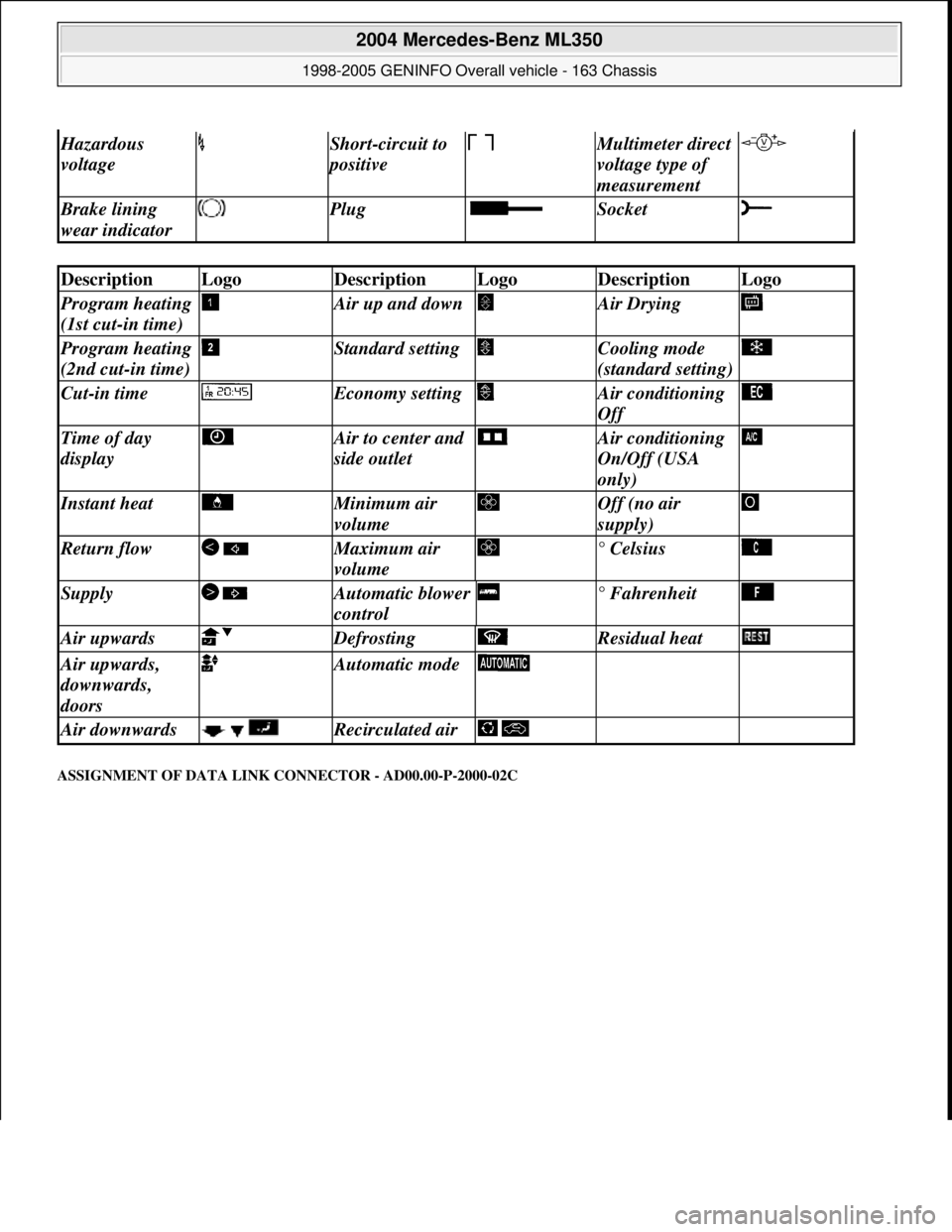
ASSIGNMENT OF DATA LINK CONNECTOR - AD00.00-P-2000-02C
Hazardous
voltage Short-circuit to
positive
Multimeter direct
voltage type of
measurement
Brake lining
wear indicator Plug Socket
DescriptionLogoDescriptionLogoDescriptionLogo
Program heating
(1st cut-in time) Air up and down Air Drying
Program heating
(2nd cut-in time) Standard setting Cooling mode
(standard setting)
Cut-in time Economy setting Air conditioning
Off
Time of day
display Air to center and
side outlet Air conditioning
On/Off (USA
only)
Instant heat Minimum air
volume Off (no air
supply)
Return flow Maximum air
volume ° Celsius
Supply Automatic blower
control ° Fahrenheit
Air upwards Defrosting Residual heat
Air upwards,
downwards,
doors Automatic mode
Air downwards Recirculated air
2004 Mercedes-Benz ML350
1998-2005 GENINFO Overall vehicle - 163 Chassis
me
Saturday, October 02, 2010 3:47:48 PMPage 239 © 2006 Mitchell Repair Information Company, LLC.
Page 3051 of 4133

RENDER NEW VEHICLES, WHICH WERE IMMOBILIZED OPERATIONAL - AP00.70-P-1001ZZ
MODEL 129, 140, 163, 168, 170, 202, 203, 208, 209, 210, 211, 215, 220, 230, 240
MODEL 461.302 /332 /342 /345
MODEL
463.200 /204 /206 /207 /208 /209 /220 /221 /224/225 /227 /228 /230 /231 /232 /233 /240 /241 /243 /244 /245 /2
4
servicerecommend that the
vehicle fuel tank is
completely filled. Then
allow gasoline engines to
run warm for 2-3 minutes.
Notes on paintwork,
decorative and detachable
components AH98.00-P-9019-01Z
if necessary, corrosion
protection after painting
(Section D) AP98.00-P-0641A
1Perform delivery
inspection
2Check battery AR54.10-P-1129-01A
3
+Vent stationary heater and
top up coolantModel 163, 168, 170, 202,
203, 208, 209, 210, 211,
215, 220, 230, 240, 461,
463
Models 129, 140 with
stationary heater, code 228ra83001291165x
4Check fluid level of
engine cooling system,
correct if necessary and
check corrosion protection
as well as antifreeze and
correct if necessaryModel 129, 140, 163, 168,
170, 202, 203, 208, 209,
210, 211, 215, 220, 230,
240
Model 463 with engine
112, 113AP20.00-P-2010GA
Models 461, 463 with
engines 102, 103, 104,
117, 602, 603, 606, 612,
628AP20.00-P-2010G
Risk of accident caused
by vehicle starting off by
itself when engine is
running. Risk of injury
caused by contusions and
burns during starting Secure vehicle to prevent
it from moving. Wear
closed and snug-fitting
work clothes. Do not grasp
hot or rotating parts.AS00.00-Z-0005-01A
2004 Mercedes-Benz ML350
1998-2005 GENINFO Overall vehicle - 163 Chassis
me
Saturday, October 02, 2010 3:47:52 PMPage 406 © 2006 Mitchell Repair Information Company, LLC.
Page 3168 of 4133

etc. of these coolant specifications also apply. It is imperative that the correct concentration (50/50) is
used in their application and, of course, further dilution is not permitted!
Approval status:
Coolants for all vehicle and engines (Basis 325.0) Sheet 326.0
Coolants for commercial vehicle and industrial engines (Basis 325.2) Sheet 326.2
Coolants for commercial vehicle and industrial engines (Basis 325.3) Sheet 326.3
The regulations for each respective Sheet 325.x are to be transferred correspondingly to Sheet
326.x.
At the time of compiling these regulations it is possible that not all the Sheets 326.x are represented with
approved products.
2.Coolant additives (General information)
Normally, coolant consists of water and anticorrosion/antifreeze agents. The anticorrosion/antifreeze
agents (ethylene glycol with corrosions inhibitors) in the cooling system have to fulfill, among other
things, the following functions:
to provide sufficient corrosion and cavitation protection for all cooling system components
freezing point depression (antifreeze)
increasing boiling point
For corrosion protection purposes the coolant
approx. 50 vol.-% Anticorrosion/antifreeze agents are added if the expected ambient temperatures do not
require an even higher concentration. This concentration (50 vol %) offers frost protection up to approx. -
37°C. A higher concentration is only necessary if the ambient temperatures are even lower.
Even with extremely low ambient temperatures, not more than 55 vol.-% anticorrosion/antifreeze agent
should be used, because at this level the maximum antifreeze protection is reached and a greater
concentration reduces the antifreeze protection again and decreases the heat dissipation (55 vol.-%
corresponds to antifreeze protection down to approx. -45°C).
Should these coolant regulations fail to be observed then corrosion and damage to the cooling
system are inevitable.
The admixture of anticorrosion/antifreeze agent serves to increase the boiling point. By raising the
pressure the boiling temperature can be increased yet further. Both physical relationships are put to use in
modern cooling systems - the maximum coolant temperature is raised, without increasing the danger of
boiling. In keeping with the higher temperature level the cooling performance is also greater. Only
approved products (Sheet 325.0/326.0 or 325.2 or 326.2, 325.3 or 326.3 as well as 312.0 or 311.0)
2004 Mercedes-Benz ML350
1998-2005 GENINFO Overall vehicle - 163 Chassis
me
Saturday, October 02, 2010 3:47:57 PMPage 523 © 2006 Mitchell Repair Information Company, LLC.
Page 3169 of 4133
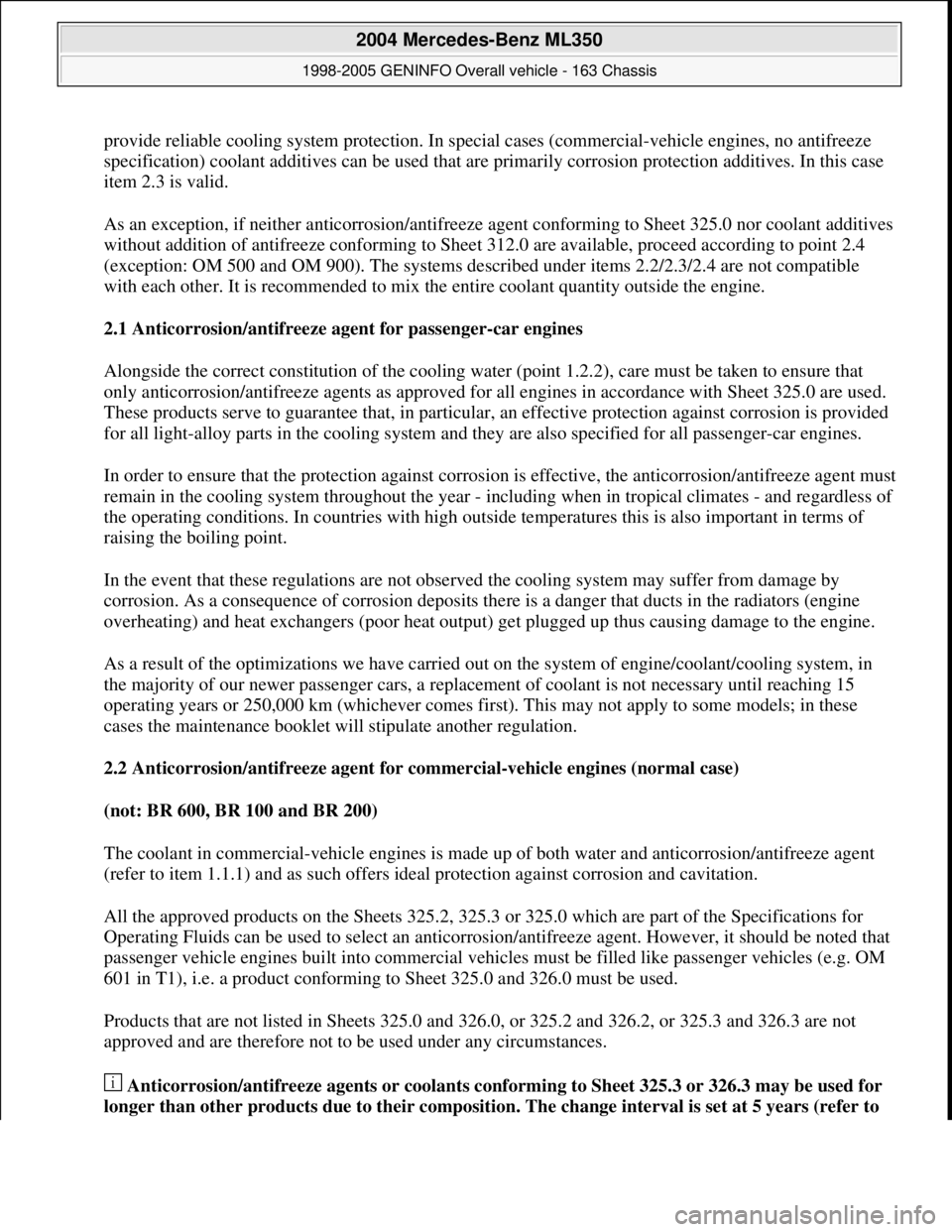
provide reliable cooling system protection. In special cases (commercial-vehicle engines, no antifreeze
specification) coolant additives can be used that are primarily corrosion protection additives. In this case
item 2.3 is valid.
As an exception, if neither anticorrosion/antifreeze agent conforming to Sheet 325.0 nor coolant additives
without addition of antifreeze conforming to Sheet 312.0 are available, proceed according to point 2.4
(exception: OM 500 and OM 900). The systems described under items 2.2/2.3/2.4 are not compatible
with each other. It is recommended to mix the entire coolant quantity outside the engine.
2.1 Anticorrosion/antifreeze agent for passenger-car engines
Alongside the correct constitution of the cooling water (point 1.2.2), care must be taken to ensure that
only anticorrosion/antifreeze agents as approved for all engines in accordance with Sheet 325.0 are used.
These products serve to guarantee that, in particular, an effective protection against corrosion is provided
for all light-alloy parts in the cooling system and they are also specified for all passenger-car engines.
In order to ensure that the protection against corrosion is effective, the anticorrosion/antifreeze agent must
remain in the cooling system throughout the year - including when in tropical climates - and regardless of
the operating conditions. In countries with high outside temperatures this is also important in terms of
raising the boiling point.
In the event that these regulations are not observed the cooling system may suffer from damage by
corrosion. As a consequence of corrosion deposits there is a danger that ducts in the radiators (engine
overheating) and heat exchangers (poor heat output) get plugged up thus causing damage to the engine.
As a result of the optimizations we have carried out on the system of engine/coolant/cooling system, in
the majority of our newer passenger cars, a replacement of coolant is not necessary until reaching 15
operating years or 250,000 km (whichever comes first). This may not apply to some models; in these
cases the maintenance booklet will stipulate another regulation.
2.2 Anticorrosion/antifreeze agent for commercial-vehicle engines (normal case)
(not: BR 600, BR 100 and BR 200)
The coolant in commercial-vehicle engines is made up of both water and anticorrosion/antifreeze agent
(refer to item 1.1.1) and as such offers ideal protection against corrosion and cavitation.
All the approved products on the Sheets 325.2, 325.3 or 325.0 which are part of the Specifications for
Operating Fluids can be used to select an anticorrosion/antifreeze agent. However, it should be noted that
passenger vehicle engines built into commercial vehicles must be filled like passenger vehicles (e.g. OM
601 in T1), i.e. a product conforming to Sheet 325.0 and 326.0 must be used.
Products that are not listed in Sheets 325.0 and 326.0, or 325.2 and 326.2, or 325.3 and 326.3 are not
approved and are therefore not to be used under any circumstances.
Anticorrosion/antifreeze agents or coolants conforming to Sheet 325.3 or 326.3 may be used for
longer than other products due to their composition. The change interval is set at 5 years (refer to
2004 Mercedes-Benz ML350
1998-2005 GENINFO Overall vehicle - 163 Chassis
me
Saturday, October 02, 2010 3:47:57 PMPage 524 © 2006 Mitchell Repair Information Company, LLC.
Page 3171 of 4133
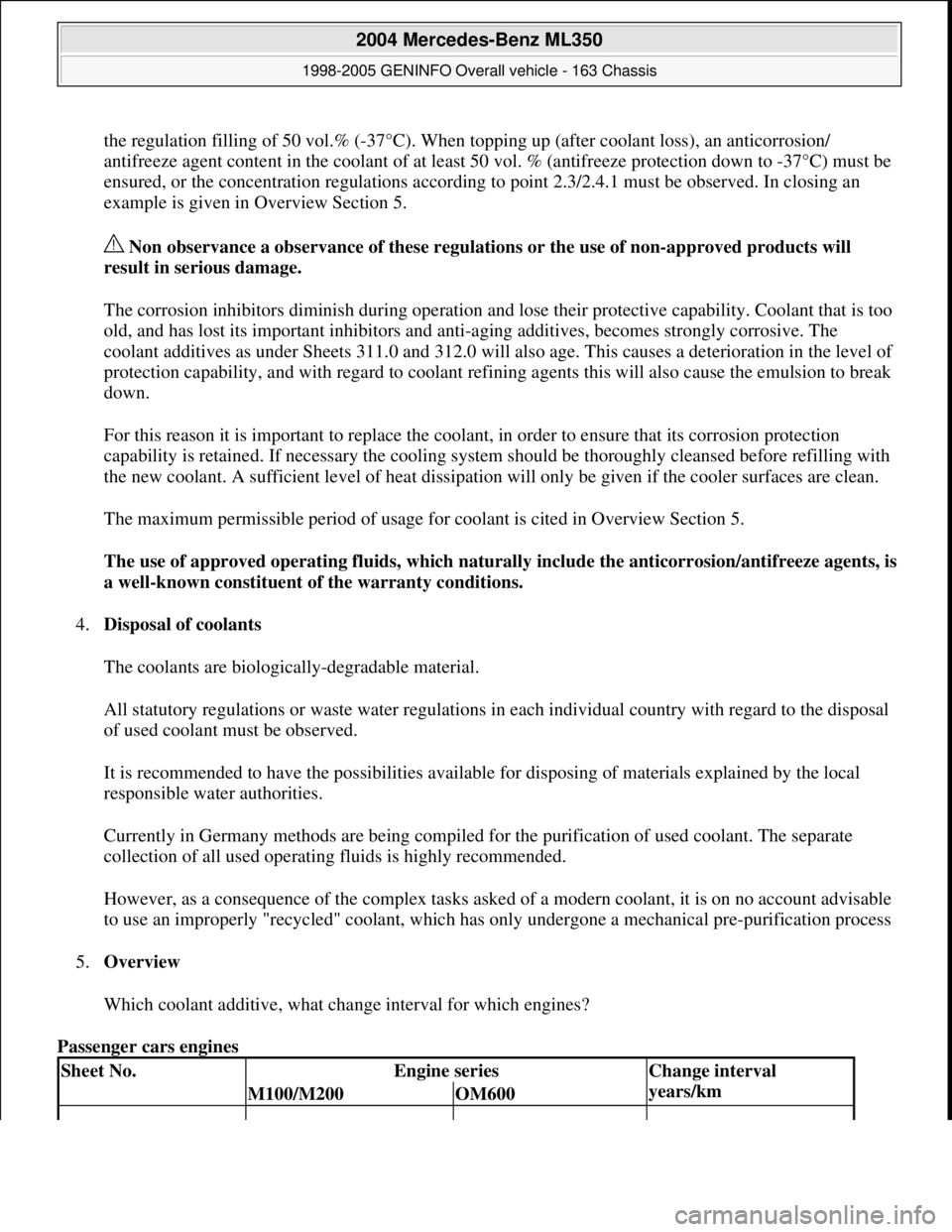
the regulation filling of 50 vol.% (-37°C). When topping up (after coolant loss), an anticorrosion/
antifreeze agent content in the coolant of at least 50 vol. % (antifreeze protection down to -37°C) must be
ensured, or the concentration regulations according to point 2.3/2.4.1 must be observed. In closing an
example is given in Overview Section 5.
Non observance a observance of these regulations or the use of non-approved products will
result in serious damage.
The corrosion inhibitors diminish during operation and lose their protective capability. Coolant that is too
old, and has lost its important inhibitors and anti-aging additives, becomes strongly corrosive. The
coolant additives as under Sheets 311.0 and 312.0 will also age. This causes a deterioration in the level of
protection capability, and with regard to coolant refining agents this will also cause the emulsion to break
down.
For this reason it is important to replace the coolant, in order to ensure that its corrosion protection
capability is retained. If necessary the cooling system should be thoroughly cleansed before refilling with
the new coolant. A sufficient level of heat dissipation will only be given if the cooler surfaces are clean.
The maximum permissible period of usage for coolant is cited in Overview Section 5.
The use of approved operatin
g fluids, which naturally include the anticorrosion/antifreeze agents, is
a well-known constituent of the warranty conditions.
4.Disposal of coolants
The coolants are biologically-degradable material.
All statutory regulations or waste water regulations in each individual country with regard to the disposal
of used coolant must be observed.
It is recommended to have the possibilities available for disposing of materials explained by the local
responsible water authorities.
Currently in Germany methods are being compiled for the purification of used coolant. The separate
collection of all used operating fluids is highly recommended.
However, as a consequence of the complex tasks asked of a modern coolant, it is on no account advisable
to use an improperly "recycled" coolant, which has only undergone a mechanical pre-purification process
5.Overview
Which coolant additive, what change interval for which engines?
Passenger cars engines
Sheet No.Engine seriesChange interval
years/km
M100/M200OM600
2004 Mercedes-Benz ML350
1998-2005 GENINFO Overall vehicle - 163 Chassis
me
Saturday, October 02, 2010 3:47:57 PMPage 526 © 2006 Mitchell Repair Information Company, LLC.
Page 3174 of 4133
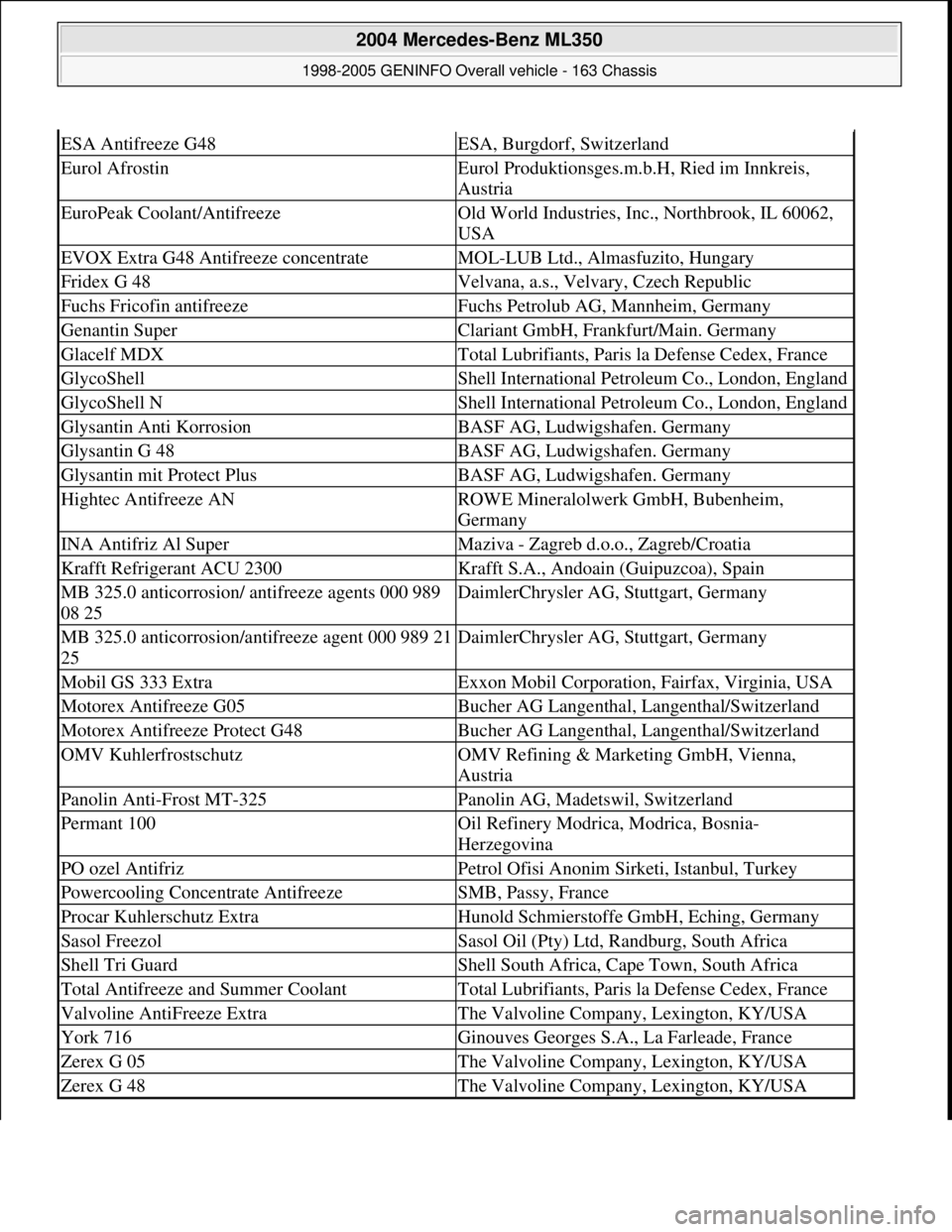
ESA Antifreeze G48ESA, Burgdorf, Switzerland
Eurol AfrostinEurol Produktionsges.m.b.H, Ried im Innkreis,
Austria
EuroPeak Coolant/AntifreezeOld World Industries, Inc., Northbrook, IL 60062,
USA
EVOX Extra G48 Antifreeze concentrateMOL-LUB Ltd., Almasfuzito, Hungary
Fridex G 48Velvana, a.s., Velvary, Czech Republic
Fuchs Fricofin antifreezeFuchs Petrolub AG, Mannheim, Germany
Genantin SuperClariant GmbH, Frankfurt/Main. Germany
Glacelf MDXTotal Lubrifiants, Paris la Defense Cedex, France
GlycoShellShell International Petroleum Co., London, England
GlycoShell NShell International Petroleum Co., London, England
Glysantin Anti KorrosionBASF AG, Ludwigshafen. Germany
Glysantin G 48BASF AG, Ludwigshafen. Germany
Glysantin mit Protect PlusBASF AG, Ludwigshafen. Germany
Hightec Antifreeze ANROWE Mineralolwerk GmbH, Bubenheim,
Germany
INA Antifriz Al SuperMaziva - Zagreb d.o.o., Zagreb/Croatia
Krafft Refrigerant ACU 2300Krafft S.A., Andoain (Guipuzcoa), Spain
MB 325.0 anticorrosion/ antifreeze agents 000 989
08 25DaimlerChrysler AG, Stuttgart, Germany
MB 325.0 anticorrosion/antifreeze agent 000 989 21
25DaimlerChrysler AG, Stuttgart, Germany
Mobil GS 333 ExtraExxon Mobil Corporation, Fairfax, Virginia, USA
Motorex Antifreeze G05Bucher AG Langenthal, Langenthal/Switzerland
Motorex Antifreeze Protect G48Bucher AG Langenthal, Langenthal/Switzerland
OMV KuhlerfrostschutzOMV Refining & Marketing GmbH, Vienna,
Austria
Panolin Anti-Frost MT-325Panolin AG, Madetswil, Switzerland
Permant 100Oil Refinery Modrica, Modrica, Bosnia-
Herzegovina
PO ozel AntifrizPetrol Ofisi Anonim Sirketi, Istanbul, Turkey
Powercooling Concentrate AntifreezeSMB, Passy, France
Procar Kuhlerschutz ExtraHunold Schmierstoffe GmbH, Eching, Germany
Sasol FreezolSasol Oil (Pty) Ltd, Randburg, South Africa
Shell Tri GuardShell South Africa, Cape Town, South Africa
Total Antifreeze and Summer CoolantTotal Lubrifiants, Paris la Defense Cedex, France
Valvoline AntiFreeze ExtraThe Valvoline Company, Lexington, KY/USA
York 716Ginouves Georges S.A., La Farleade, France
Zerex G 05The Valvoline Company, Lexington, KY/USA
Zerex G 48The Valvoline Company, Lexington, KY/USA
2004 Mercedes-Benz ML350
1998-2005 GENINFO Overall vehicle - 163 Chassis
me
Saturday, October 02, 2010 3:47:57 PMPage 529 © 2006 Mitchell Repair Information Company, LLC.
Page 3214 of 4133
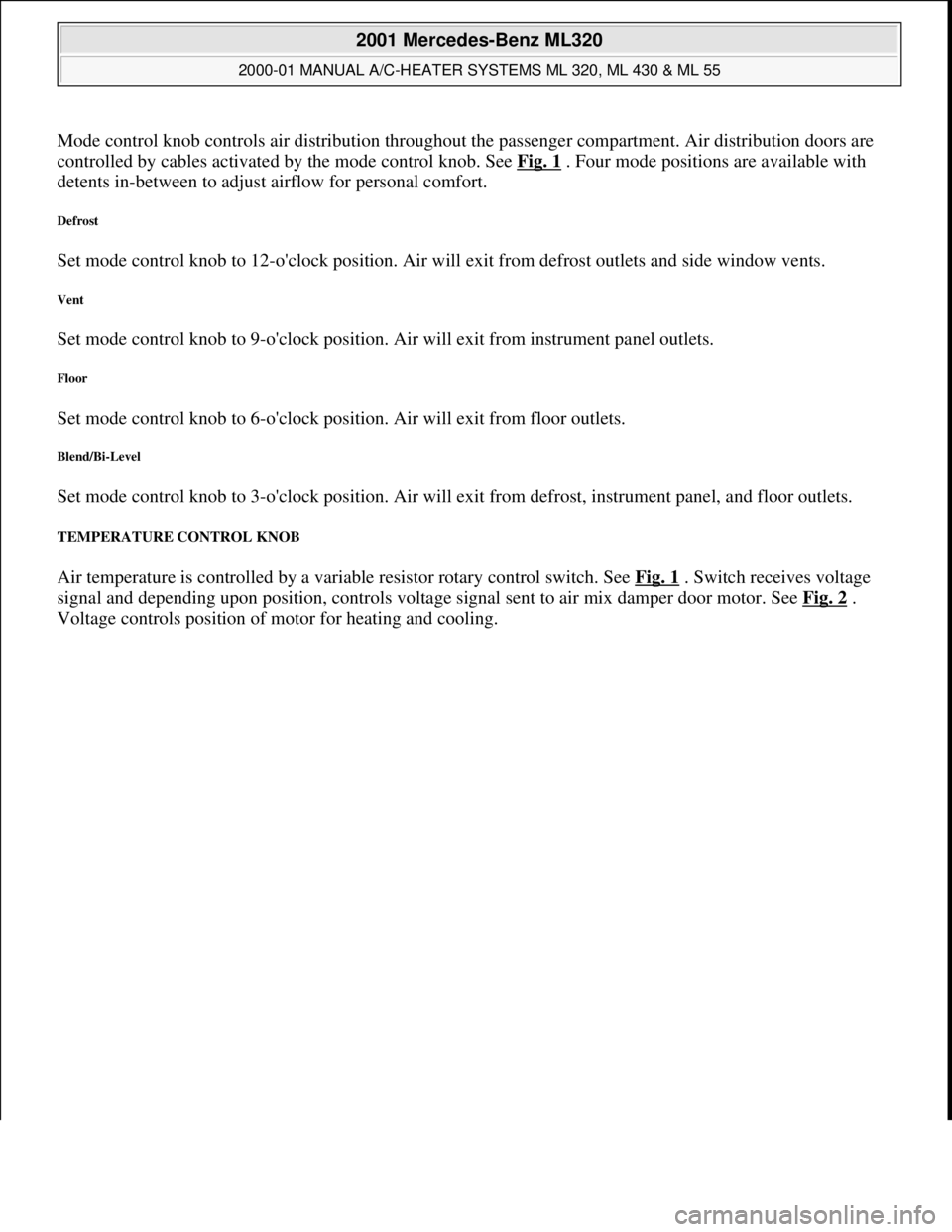
Mode control knob controls air distribution throughout the passenger compartment. Air distribution doors are
controlled by cables activated by the mode control knob. See Fig. 1
. Four mode positions are available with
detents in-between to adjust airflow for personal comfort.
Defrost
Set mode control knob to 12-o'clock position. Air will exit from defrost outlets and side window vents.
Vent
Set mode control knob to 9-o'clock position. Air will exit from instrument panel outlets.
Floor
Set mode control knob to 6-o'clock position. Air will exit from floor outlets.
Blend/Bi-Level
Set mode control knob to 3-o'clock position. Air will exit from defrost, instrument panel, and floor outlets.
TEMPERATURE CONTROL KNOB
Air temperature is controlled by a variable resistor rotary control switch. See Fig. 1 . Switch receives voltage
signal and depending upon position, controls voltage signal sent to air mix damper door motor. See Fig. 2
.
Volta
ge controls position of motor for heating and cooling.
2001 Mercedes-Benz ML320
2000-01 MANUAL A/C-HEATER SYSTEMS ML 320, ML 430 & ML 55
me
Saturday, October 02, 2010 3:25:10 PMPage 3 © 2006 Mitchell Repair Information Company, LLC.